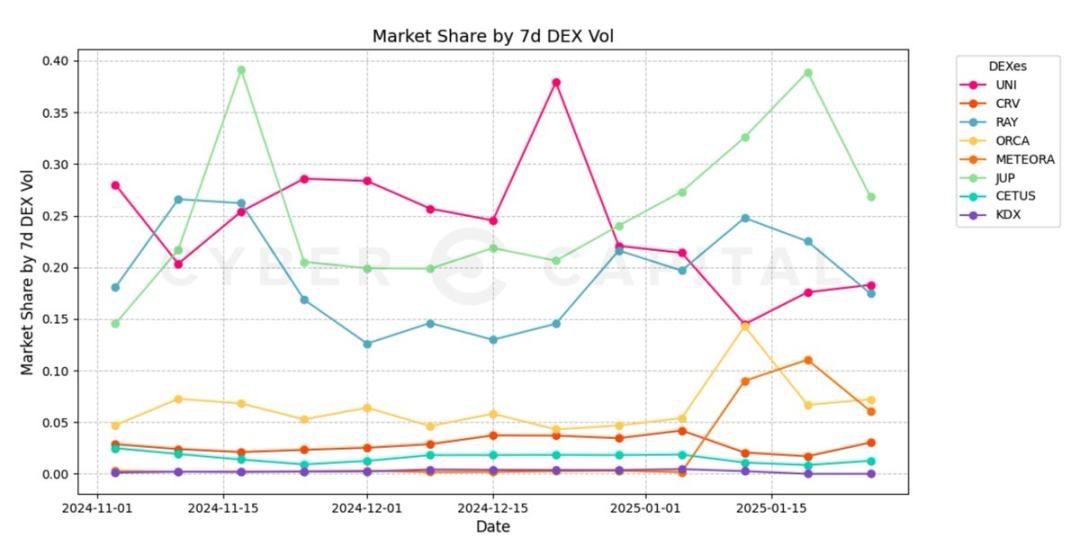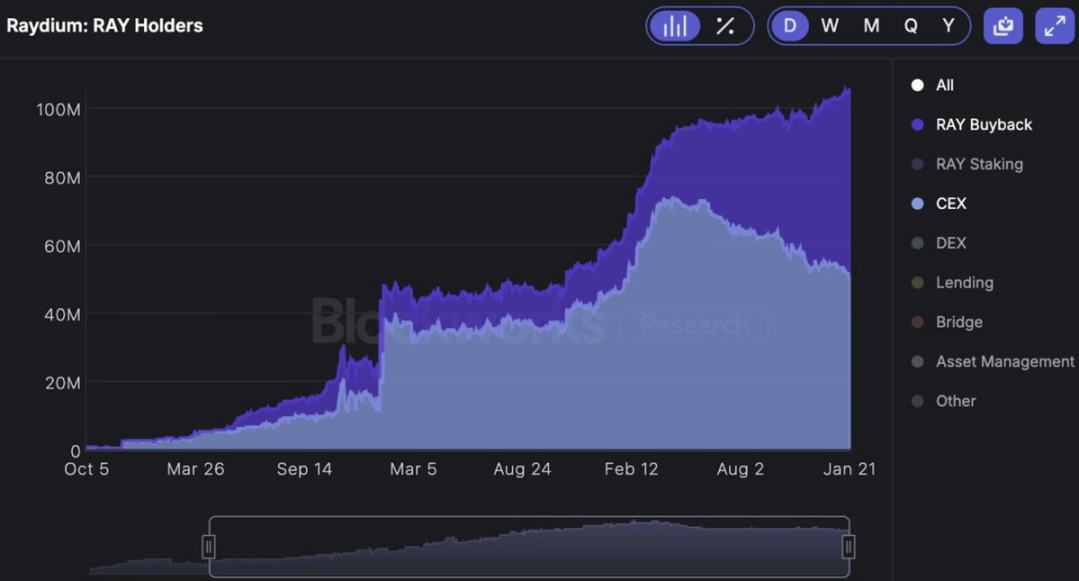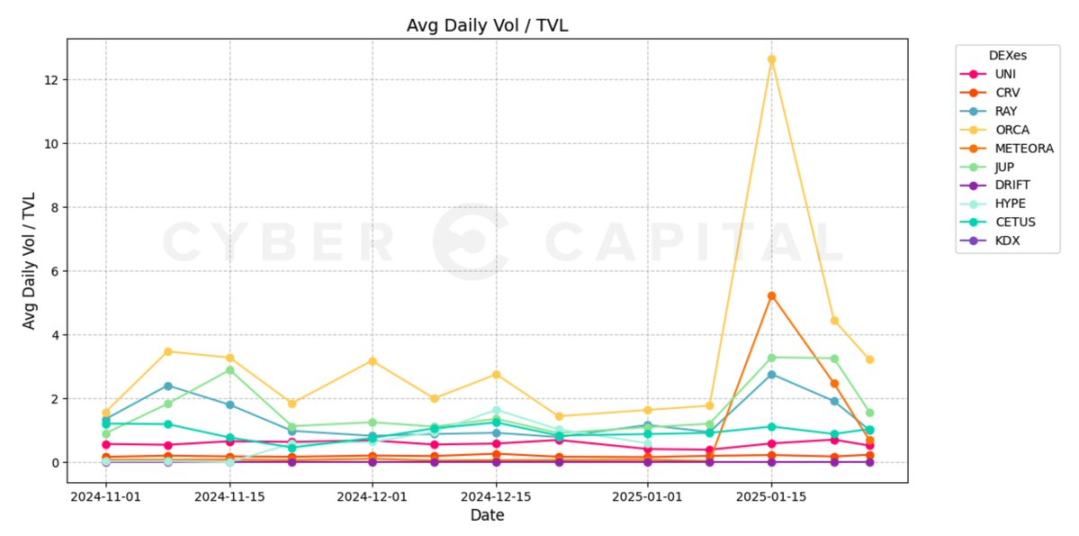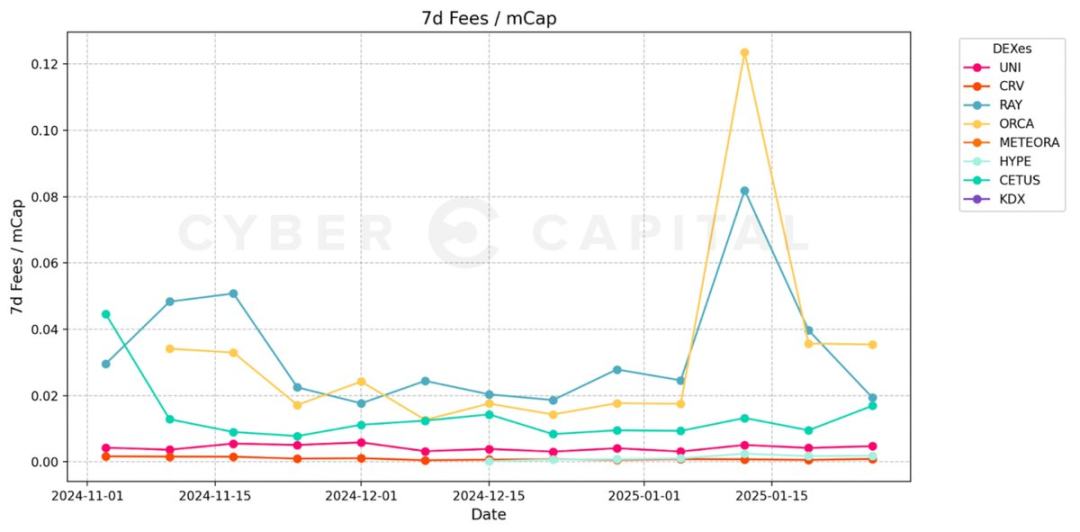A quick look at the Solana DEX competition landscape: Raydium, Jupiter, Orca and Meteora, which one has more potential
原作者: vik0nchain , Cyber Capital researcher
原文翻訳: ルフィ、フォーサイトニュース
From Q4 2024 to early 2025, the competitive landscape of Solana’s DeFi ecosystem has gradually emerged, mainly reflected in the rise of aggregators, user experience (UX) abstraction, major integrations, and evolving token economic standards. Although these changes were not obvious at first, recent data has clearly shown the impact, especially in the redistribution of liquidity, fee generation, and changes in market share.
This analysis takes a deep dive into the liquidity positioning of the major Solana-based decentralized exchanges (DEXs) – Raydium, Jupiter, Orca, and Meteora – focusing on their strengths, weaknesses, and potential investment implications relative to existing and emerging competitors.
Investment Analysis Framework
Raydium (RAY) has a positive outlook: deep liquidity and buyback advantages
-
Liquidity and Volume Dominance: Raydium remains the most liquid and heavily used DEX in the Solana ecosystem. Over 55% of trades routed through Jupiter are settled on Raydium. In addition, Raydium leads the market alongside and sometimes surpasses long-time leader Uniswap among DEXs on all blockchains, while having a fully diluted valuation (FDV) and market cap of only about one-third of Uniswap.
-
Raydium/Uniswap fully diluted valuation ratio: $2872828346 million / $9102379018 million = 31.5%
-
Raydium/Uniswap market cap ratio: $1505604427 million / $5465824531 million = 27.5%
-
Pump.fun Integration: Key partnerships including integration with Pump.fun, boosting trading volume and protocol stickiness due to the migration of all new Meme pools to Raydium.
-
トークン buyback: Raydiums 12% fee buyback program has bought back more than 10% of the total supply, significantly reducing selling pressure. It is worth noting that the amount Raydium has bought back significantly exceeds the amount held by centralized exchanges.
Jupiter (JUP) Positive Outlook: 市場-Leading Aggregator
-
Liquidity Aggregation Advantage: Jupiter plays a key role as Solana’s dominant aggregator.
-
Acquisition of Moonshot: The acquisition of Moonshot enables Jupiter to integrate deposit/withdrawal channels within its decentralized exchange, improving its competitiveness by simplifying the user experience.
-
Unlocking pressure: Due to token unlocking, Jupiter faces a 127% supply growth, which brings medium-term inflation risk. Despite the recently announced buyback mechanism, the internal estimated annual buyback rate is 2.4%, which provides some support for the token economy, but has limited role in competing with Raydium.
-
Business model: Since aggregator fees are charged in addition to the underlying protocol fees, the aggregator model faces difficulties in terms of low fees.
-
Lack of competitors: As the first aggregator on Solana, Jupiter lacks strong competitors.
Meteora is optimistic: the rise of liquidity aggregators
-
Aggregated Liquidity Efficiency: Unlike independent decentralized exchanges, aggregators like Meteora inherently have lower downside risk and more stable capital efficiency.
-
Token issuance catalyst: The successful issuance of Meteora tokens may change liquidity preferences and provide a long-term boost to its market positioning. Unlike industry LP leader Kamino, MET points are not publicly displayed on the user interface. In addition, there has been no official announcement about airdrops since the MET points system was first announced more than a year ago. Although liquidity providers can earn higher returns elsewhere in the ecosystem (such as lulo.fi), market positioning and airdrop expectations may be the main drivers for liquidity providers.
-
TVL Retention: Meteora has grown on major events such as the Pengu airdrop and the Trump and Melania Trump-related Memecoin launch. While many trading pairs saw a rise in Vol/TVL ratios due to temporary demand during the Memecoin launch, Meteora’s TVL continued to rise after the event, showing good retention.
-
Integration Development: Virtuals migrated to Solana in Q1 2024 and announced integration with the Meteora liquidity pool.
Orcas outlook is pessimistic: insufficient liquidity retention
-
Insufficient liquidity depth: Despite being extremely efficient, Orca’s funding pool is significantly smaller than Raydium’s, resulting in higher slippage for large trades.
-
Market positioning problem: Jupiter’s routing mechanism prioritizes exchanges with deeper liquidity, making emerging low-liquidity decentralized exchanges and liquidity pools unattractive.
-
Meteora’s emergence as a liquidity aggregator further limits the competitive viability of non-dominant DEXs in the routing framework, as trades will only be routed when the slippage cost is lower than Meteora’s fee premium, which is extremely rare outside of market demand surges.
-
Limited liquidity provider incentives: Orca lacks a strong liquidity mining strategy, resulting in low long-term liquidity provider retention.
-
Inefficient capital allocation: Unlike Meteora, Orca has not yet implemented automated yield optimization and requires manual management of LPs, resulting in a more cumbersome user experience.
-
Unfavorable liquidity trends: The upcoming launch of the Meteora token may attract liquidity providers away from Orca entirely, making its situation even more difficult.
-
Insufficient integration: The failure to reach a partnership with Pump.fun in early 2024 and the recent loss of cooperation with Virtuals highlight its competitive disadvantage in acquiring order flow from emerging retail-driven applications. Without an upcoming catalyst to reverse this trend, liquidity migration is likely to continue.
-
The above factors resulted in Orcas inability to retain the additional users it acquired during periods of peak network demand.
Key catalysts and risks
Catalysts to watch
-
Comparison of RAY repurchase and centralized exchange holdings: The repurchase rate of RAY has now exceeded the total amount of RAY held by centralized exchanges, reinforcing the scarcity of tokens.
-
Total locked value growth trend: The continued dominance of Raydium, Jupiter, and Meteora indicates the sustainability of long-term liquidity. In high-stress market conditions, the stickiness of emerging protocols is worthy of attention and cannot be ignored.
-
Partnerships: Just as Pumpfun’s integration brought significant liquidity to Raydium, Meteora’s integration with Virtuals could have a similar effect. Partnerships with lesser-known players are of interest given the impact of partnerships of this magnitude on liquidity and total locked value.
-
Meteora’s Token Launch: This event could mark a turning point in the distribution of liquidity on the Solana decentralized exchange.
-
Fee-to-Market Cap Ratio: Orca demonstrates extreme efficiency in high-demand months, but its lack of liquidity retention hinders long-term competitiveness. JUP, on the other hand, faces the opposite situation, limited by its business model. Compared to the latest “hot project” Hyperliquid, Raydium generates ten times the fees at one-eighth the fully diluted valuation.
リスク
-
Inflationary Pressure on JUP: While Jupiter’s position as an aggregator is solid, its large token supply could create short-term price pressure.
-
Orca’s market share decline: If the trend of liquidity provider migration continues, Orca may face continued liquidity loss.
-
Meteora エアドロップ and Token Economic Execution Risk: Despite strong early TLV growth, its token economics and incentive structure remain untested.
Conclusion and investment outlook
Solana’s DEX landscape is shifting toward greater efficiency and deeper liquidity concentration. Raydium’s superior liquidity positioning, active buyback mechanism, and market dominance make it a highly investable DEX. Jupiter’s aggregator role remains critical and provides a competitive barrier, but token supply dilution poses near-term headwinds. Orca, once a competitive player, faces severe challenges in liquidity retention and capital efficiency, becoming an increasingly vulnerable asset, demonstrating the plight of missing out on key integrations and struggling to compete head-on with established players. Meteora is poised to rise after a successful launch of its upcoming token. Based on our current theory, DEX investment positions should be concentrated in the leading DEXs, DEX aggregators, and liquidity aggregators in a given ecosystem, with emerging players that meet the catalyst criteria also being able to hold small positions.
This article is sourced from the internet: A quick look at the Solana DEX competition landscape: Raydium, Jupiter, Orca and Meteora, which one has more potential
Related: $92,000, is this Bitcoin’s short-term “iron bottom”?
Original author: BitpushNews Mary Liu Cryptocurrency markets fell slightly on Tuesday after U.S. President Donald Trump announced a 25% tariff on imported steel and aluminum. According to Bitpush data, Bitcoin fell 1.63% in the past 24 hours and is currently trading below $96,000, while Ethereum fell 2.12% to around $2,600. XRP and Solana (SOL) did not fluctuate much. In the past 24 hours, the total market value of cryptocurrencies fell by 0.98% to $3.15 trillion. CoinGlass data shows that during the same period, the total amount of liquidation in the entire crypto network reached $233 million, mainly long orders, equivalent to about $149 million. Trump tariffs and macroeconomic uncertainty Tracy Jin, vice president of cryptocurrency exchange MEXC, attributed the markets movement primarily to the Federal Reserves recent decision to keep…












